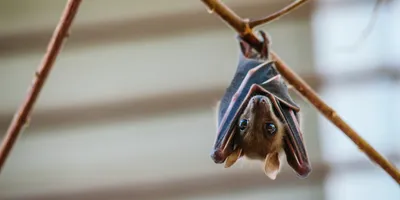 CREDIT: Emma Teeling
CREDIT: Emma Teeling
Are Bats Really Blind?
The phrase "blind as a bat" is widely used to describe poor vision, but is it actually true? A recent study led by Bruno Simões and Emma Teeling has examined color vision genes in bats, providing new insights into how bats see the world. While some species have sacrificed elements of vision in favor of enhanced echolocation, others retain UV and color vision, showing that vision remains a crucial sensory tool even in nocturnal species.
The research examined 111 bat species, analyzing their genetic adaptations for vision and echolocation. The findings suggest that some bats have retained a functional ability to detect UV light, while others have lost this capacity due to evolutionary tradeoffs. Importantly, the study sheds light on how ecological niche, roosting behavior, and sensory reliance contribute to variations in bat vision. This challenges the long-held belief that bats universally possess poor eyesight, demonstrating that their vision is highly specialized and adapted to their environment.
How Do Bats See?
Bats rely on two primary sensory systems to navigate and find food:
- Vision: Some species have functional color vision, including the ability to see UV light.
- Echolocation: High-frequency sound waves help bats detect objects in total darkness.
The study focused on two critical opsin genes, which play a key role in mammalian vision:
- SWS1 (short-wavelength opsin gene) – Enables blue and UV vision.
- MWS/LWS (medium-to-long-wavelength opsin gene) – Allows vision in green, yellow, and red light.
By analyzing these genes in 111 bat species, researchers found that many bats still possess some level of functional vision, particularly in the middle and long-wavelength spectrum.
The Role of Echolocation in Bat Vision Loss
One of the study's key findings is that the loss of UV vision is linked to echolocation abilities. The research supports the idea that bats that have evolved advanced echolocation systems often lose short-wavelength vision, particularly in species that have developed high-duty cycle echolocation (a form of continuous sound emission used for navigation).
"Our work supports previous hypotheses which suggest the pseudogenization [or loss] of the SWS1 opsin may be related to the adoption of advanced echolocation (high-duty cycle) and cave roosting habits," said Emma Teeling, corresponding author of the study.
Key Findings:
- 26 out of 111 bat species have lost UV vision, indicating that echolocation-driven tradeoffs are common.
- Non-echolocating, cave-roosting bats also lose UV vision, suggesting that dark environments alone can drive vision loss.
- MWS/LWS genes remain highly conserved, meaning most bats still see in the green, yellow, and red spectrum.
Can Bats See in the Dark?
Yes! Even though many bat species are nocturnal, they still rely on vision.
- Echolocating bats use sound waves to detect objects, but many still posses functional vision for navigating large-scale environments.
- Non-echolocating bats often rely more on sight and have better-preserved color vision genes.
- Forest-dwelling bats tend to have UV-sensitive vision, aiding them in low-light environments.
Do All Bats Have the Same Vision?
No. The study found that different ecological niches influence bat vision. Bats that roost in caves and use echolocation often lose UV vision, while those that navigate in open forests are more likely to retain color vision.
"Bats are not blind, with most species capable of seeing in both the UV and middle range of the color spectrum. This suggests that vision is still an important means of sensory perception even in echolocating, nocturnal bats," said Teeling.
Evolutionary Tradeoffs: The Cost of Enhanced Echolocation
While some bats have sacrificed UV vision, the MWS/LWS opsin gene remains highly conserved across bat species. This gene allows bats to see in the green-yellow-red spectrum, suggesting that color vision remains useful even for echolocating species.
- The research team discovered multiple genetic mutations that have caused the loss of the SWS1 opsin gene in different bat lineages.
- The loss of UV vision **is not always linked to **echolocation—some cave-dwelling bats that do not echolocate also lost UV vision.
- The study challenges the previous assumption that vision loss is solely driven by echolocation.
Why Does This Matter?
This study contributes to the ongoing scientific debate about how nocturnal mammals use vision. By examining opsin genes and spectral tuning in bats, researchers provide new insights into how different species have adapted to their environments.
"Sensory trade-offs are more complex than previously considered, and bats still make fascinating subjects to understand the evolution of the mammalian sensome"
Conclusion: Are Bats Blind?
The answer is no—bats are not blind. While some species have lost UV vision, most still see in the green-yellow-red spectrum. Advanced echolocation has led to tradeoffs in vision, but bats continue to use sight as an important sensory tool.
Lab Management Certificate
The Lab Management certificate is more than training—it’s a professional advantage.
Gain critical skills and IACET-approved CEUs that make a measurable difference.
Key Takeaways:
- Most bats are not blind—they retain color vision in the middle and long wavelengths.
- Some bats have lost UV vision, especially cave-dwellers and species with advanced echolocation.
- Vision remains crucial for navigating large-scale environments and complementing echolocation.
The next time someone says "blind as a bat," you can confidently correct them—bats can see, and in some cases, they even perceive UV light!
This content includes text that has been generated with the assistance of AI. Lab Manager’s AI policy can be found here.













